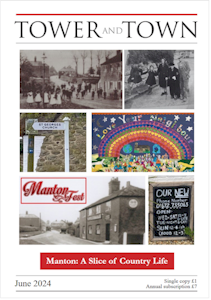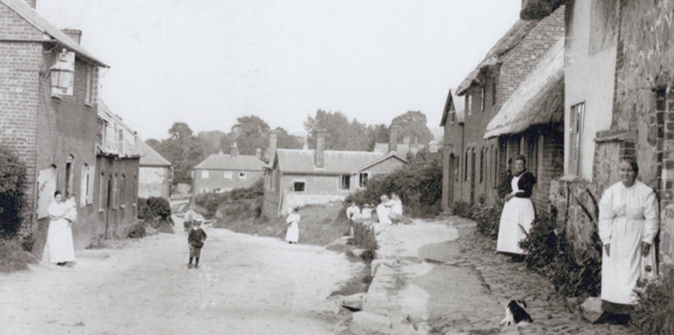

Tower and Town, June 2024 (view the full edition) (view the full edition)Country LifeAs recently as the 1960s Manton was a working country village, where residents would conduct their trade from the village or bike to work, and Manton families would take part in the harvest. Village amenities included the Post Office and Grocery store and two pubs: The Oddfellows and The New Inn (which became Up the Garden Path). There was also Matthews Builder's Yard - on Bridge Street where the flats are today - where you could take your wheelbarrow to buy just enough sand and cement for the job in hand. The Oddfellows had a 'Jug & Bottle' or off-licence where the kids would go to recycle lemonade bottles. The village has seen phenomenal changes in living memory with the 'filling in' of allotment gardens and the loss of houses, it being too expensive to install modern facilities.  The post office (top left taken by Piper Didcot) - Lyn Whatley We can play spot the difference between two photos of the PO taken some 35 years apart. The right hand picture is from c1950. The sarsen stones of the cottage on the right (in the left hand photo) became a wall on the bend to the High Street.  High Street - Sue and Tony Waite In this picture taken looking east from near the Manton Drove turn, the two cottages on the right in the foreground are no more. The Chapel and the house before it remain as does the school, and the New Inn cottages right of the road in the distance. However, their allotment gardens between the school and the cottages are now a carpark. The growing of food saw the village houses spaced out with allotments. Looking across from the Post Office you see what was 73, View Lane (renamed 'Emily's Cottage' by Lyn Whatley's mum) where Lyn spent her childhood; it is the iconic Manton Cottage. On the T&T cover you can see the Caldwells - Lyn, aged 6, on the right with her sister, mum, grandmother and dad. Mr Caldwell was a small holder keeping chickens and goats by the allotments on the land which is now Manton Hollow. When the harvest was to be gathered in everyone would help. Bull's Farm at the end of West Woods would send down a tractor and trailer for the mums and kids with picnics packed to ride to the farm to gather the potato harvest. However, at the age of 15 generally children started work; Lyn left home to work at St Mary's School in Calne. She returned to Manton when she married Dave, moving into the house next door to where she spent her childhood. Tony Waite was born in a house where the Fyfield Petrol station now stands. Fyfield, also a 'proper working village' at this end of the Kennet Valley, is set in the strange landscape of 'grey wethers' or sarsen stones. It was focused on the exploitation of the stone. Its cottages on both sides of the A4 were homes to farm workers and 'sarsen masons', or 'splinters', who largely worked at the sarsen stone business of Frees of Marlborough. Tony's father, Cecil, was a highly skilled mason, who had an eye for finding 'the line' in the stone that would allow it to be split easily. This industry finally closed in 1939. In the 1960s, much communication was in person and travel was mainly by bicycle. Whilst Tony pedalled to work in Marlborough, also cycling to work from Overton was Sue Smith. One thing led to another and they were married in Overton church in 1962. The honeymoon was moving straight into number 64, High Street, Manton. Before the wedding Tony had cycled to the estate agents in Pewsey to put in an offer on the house. On his way back he was stopped by the estate agent just driving back from Bottlesford from where the owners had accepted his offer! At that time there was only a telephone call box in the village - very handy for the Waites. Though their first two children were born at Savernake Hospital, 'Doctor Tim' decided a home confinement would be fine for their daughter. Her arrival was preceded by a 'Call the Midwife' call box moment, with Nurse Jean Nightingale being summoned. How do I know all this? Well, I've had the delightful pleasure of talking to lots of people in the village particularly the senior residents. With that I must close this peek at country life stories, which could have filled many editions of T&T. But I hope this gives you a sense of Manton, a place with history rooted in the Downs. Rich Pitts |